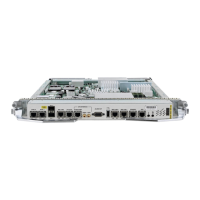DETAILED STEPS
Step 1
configure
Step 2
router static
Example:
RP/0/RSP0/CPU0:router(config)# router static
Enters static route configuration mode.
Step 3
vrf vrf-name
Example:
RP/0/RSP0/CPU0:router(config-static)# vrf vrf_A
(Optional) Enters VRF configuration mode.
If a VRF is not specified, the static route is configured under the default VRF.
Step 4
address-family { ipv4 | ipv6 } { unicast | multicast }
Example:
RP/0/RSP0/CPU0:router(config-static-vrf)# address family ipv4 unicast
Enters address family mode.
Step 5
prefix mask [vrf vrf-name ] { ip-address | interface-type interface-instance } [ distance ] [ description text ] [ tag
tag ] [ permanent ]
Example:
RP/0/RSP0/CPU0:router(config-static-vrf-afi)# 10.0.0.0/8 172.20.16.6 110
Configures an administrative distance of 110.
•
This example shows how to route packets for network 10.0.0.0 through to a next hop at 172.20.16.6 if dynamic
information with administrative distance less than 110 is not available.
Step 6
commit
A default static route is often used in simple router topologies. In the following example, a route is configured
with an administrative distance of 110.
configure
router static
address-family ipv4 unicast
0.0.0.0/0 2.6.0.1 110
end
Configure Floating Static Route
This task explains how to configure a floating static route.
Cisco ASR 9000 Series Aggregation Services Router Routing Configuration Guide, Release 5.3.x
636
Implementing Static Routes
Configure Floating Static Route

